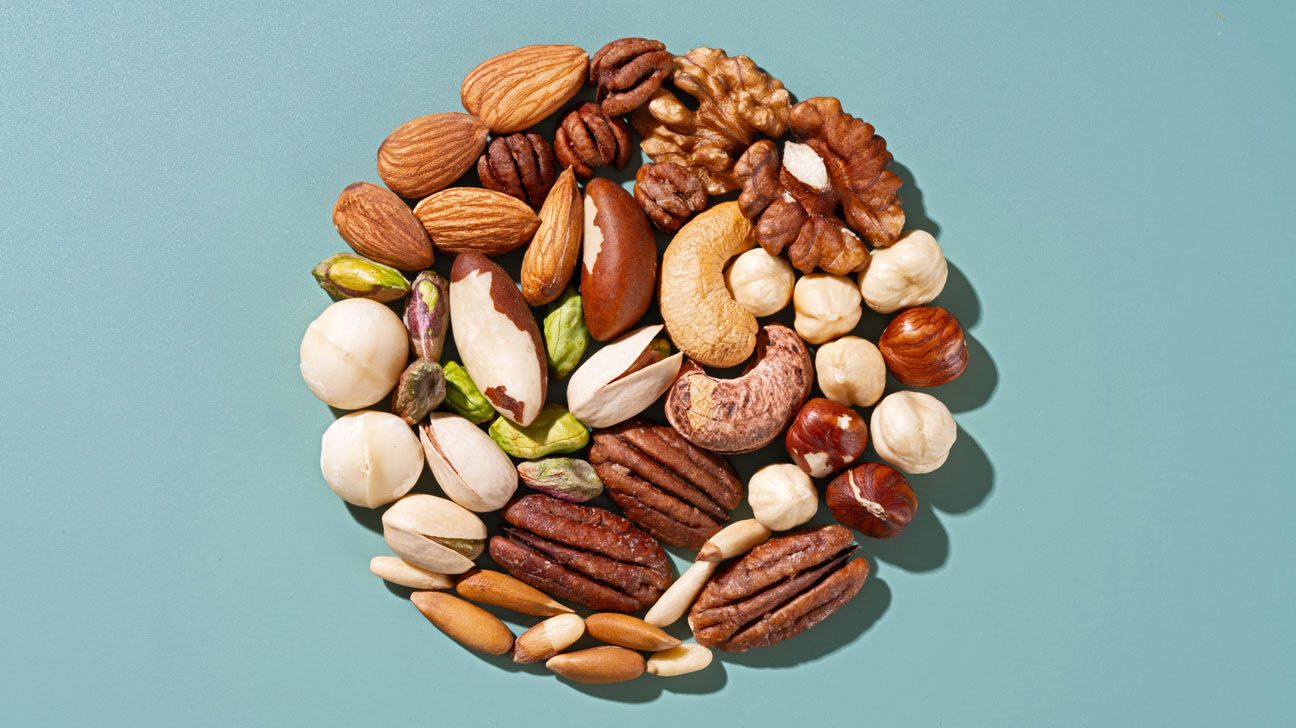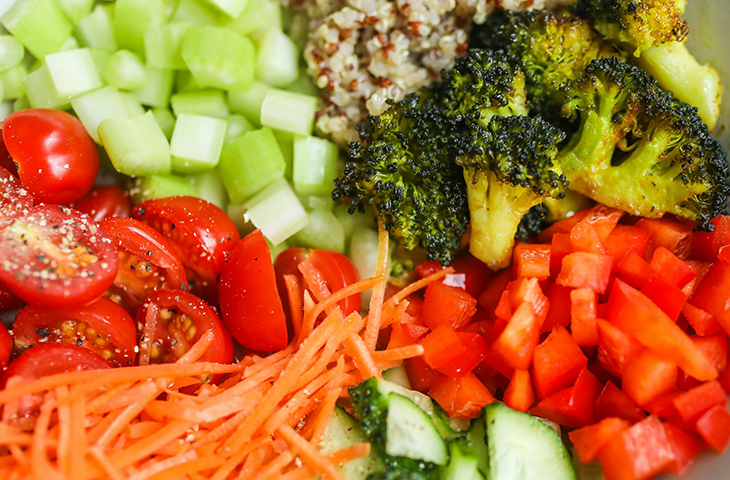Nuts, Seeds And Healthy Diet May Help Lower Risk Of Diverticulitis

A new study suggests that nuts and seeds can be consumed as part of a healthy diet by people at risk for diverticulitis.
- New research has found that nuts and seeds do not increase the risk of diverticulitis.
- The findings confirmed that four key dietary patterns, including the DASH diet, help reduce the risk of diverticulitis onset.
- The findings were consistent with a similar study previously conducted in males, refuting current recommendations about foods to avoid to prevent diverticulitis.
Diverticulitis develops when small pockets in the large intestine become inflamed. It causes uncomfortable digestive symptoms and often requires dietary modifications and restrictions.
Now, new research has confirmed that nuts and seeds, previously thought to trigger diverticulitis symptoms, could be back on the menu for people at risk for the gastrointestinal condition.
The study examined the effects of females with diverticulitis who followed four dietary patterns known to promote overall health:
- Dietary Approaches to Stop Hypertension (DASH) diet
- Healthy Eating Index (HEI)
- Alternative Healthy Eating Index (aHEI)
- Alternative Mediterranean diet
The participants consumed nuts and seeds, and the researchers also calculated how well they adhered to those four dietary patterns.
The results, published on May 6 in Annals of Internal Medicine, showed that females who followed these eating patterns had a reduced risk of diverticulitis.
The researchers concluded that nuts and seeds were not associated with an increased risk of the condition.
The findings are consistent with a 2008 study that found the same outcomes for males, which could lead to a shift in dietary recommendations for people at risk for the condition.
“We included fresh fruit with edible seeds (raw tomatoes and strawberries) in our analyses because patients still commonly report avoiding these nutritious foods,” the study authors wrote. “Our findings refute the widely held belief that dietary intake of particulate matter should be avoided to prevent diverticulitis.”
Nuts, seeds not associated with diverticulitis risk
The new research included 29,916 questionnaires received from females with no previous history of diverticulitis, inflammatory bowel disease, or cancer.
The participants were enrolled in the Sister Study, a long-running project to learn more about those who are siblings of someone with breast cancer.
Of those females, 1,531 cases of diverticulitis were identified.
Beyond finding that nuts and seeds do not increase the risk of diverticulitis, the researchers also found that the healthy dietary patterns were not associated with any risk of underlying diverticulitis.
Shabnam Sarker, MD, an assistant professor of medicine in the department of gastroenterology, hepatology, and nutrition at Vanderbilt University Medical Center, said that the findings support patients and clinicians in finding the best ways to reduce the risk of symptoms. Sarker wasn’t involved in the new study.
“I think this study kind of confirmed what we’ve been doing in our practice, or at least I’ve been doing in my practice for a long time,” Sarker said.
“So, I think earlier in our training, or years ago, we used to think that seeds were at risk of being trapped within diverticula… and we thought maybe that was a trigger on why some people had recurrent disease. And then through [further research] we’ve realized that a high fiber diet is really the best for overall colon health,” she noted.
How is diverticulitis treated?
Diverticulitis is a complication of diverticulosis, where diverticula, commonly known as pouches, develop within the colon.
When these pouches become inflamed, pain, bloating, and the potential for more serious complications like abscesses, obstructions, and perforations may occur.
Diverticulosis is common, particularly among older adults. The National Institutes of Health (NIH) estimates that around 30% of U.S. adults ages 50–59 develop diverticulitis, and more than 70% of adults 80 and older are diagnosed with the disorder.
Sometimes called “uncomplicated diverticulitis,” diverticulosis requires minimal intervention, such as antibiotics and monitoring.
Diverticulitis, however, is much less common, affecting around 5% of people with diverticulosis. Complicated diverticulitis often leads to more intense treatment options, like surgery.
Those involved in the study were found to have 1,531 cases of diverticulitis, less than a third of which required hospitalization. Of those 1,531 cases, 14% required surgery and 58% had two or more recurrences.
Surgery is most often required when the condition creates perforations or abscesses that require intervention, much more common for those who have had diverticulitis multiple times.
Shawn Khodadadian, MD, medical director of Manhattan Gastroenterology, told Healthline there are multiple avenues to treatment for those having to manage diverticulitis symptoms. Khodadadian wasn’t involved in the new study.
“Generally, outpatients can be managed with pain control and oral analgesics as well as a liquid diet in the outpatient setting for uncomplicated diverticular disease,” he said.
“Oftentimes, especially in higher-risk patients, antibiotics are prescribed when indicated. Antibiotics are not always needed to manage uncomplicated outpatient diverticulitis in otherwise healthy, stable patients, but this should be left up to your doctor after a complete evaluation,” he continued.
James Cox, MD, a gastroenterologist and assistant professor at Texas Christian University, added that it’s important for people with diverticulitis to understand the limits of preventive medicine regarding the condition. Cox wasn’t involved in the new study.
“There’s nothing patients can do to prevent the development of the diverticuli or diverticulosis,” he told Healthline.
Diverticulitis may become severe
One of the common surgeries to treat complicated diverticulitis is a colectomy, which involves removing a segment of the intestine and sewing it back together.
In more serious cases, a temporary colostomy bag may be required to give the area time to heal before reattachment can occur.
Cox noted the most serious complications are often perforations.
“If there’s a perforation, then you have colonic content in the abdominal cavity, and that’s bad. That’s very hard to sew right back up. Patients will often need a temporary colostomy bag for a few months, let everything calm down, and then they get hooked up.”
Sarker added that, for her patients, it can be helpful to explore options with a colorectal surgeon earlier rather than later.
“If they’re interested, or would like to even speak to somebody as a consultation [like] a colorectal surgeon, I usually will set them up as a consultation. Even if they’re not sure, just to have met someone and talk about the option for this, so that they feel like they’re empowered, especially in a condition that seems very difficult to control,” she suggested.
Underlying causes of diverticulitis not understood
Sarker said that part of the patient-clinician relationship is building a space where conversations can flow about conditions like diverticulosis, the reason for which is largely unknown.
Future research can investigate the different risk factors for a condition in which the underlying cause is not entirely understood.
The questionnaire-based nature of the new study highlights the challenges of nutrition research. A double-blind study with a placebo, considered the gold standard in research studies, is very difficult to conduct with food.
Cox is hopeful that further research into the gut and nutrition can help shed light on why diverticulosis happens.
Khodadadian believes that more research can and should be done into the particulars of how diets can improve patients’ outcomes.
Sarker said she’d like to see more research that prioritizes women and the role nutrition has on the gut.
“I think we need a lot more research on nutrition and dietary adjustments, and I think specifically more research in women as well.”


